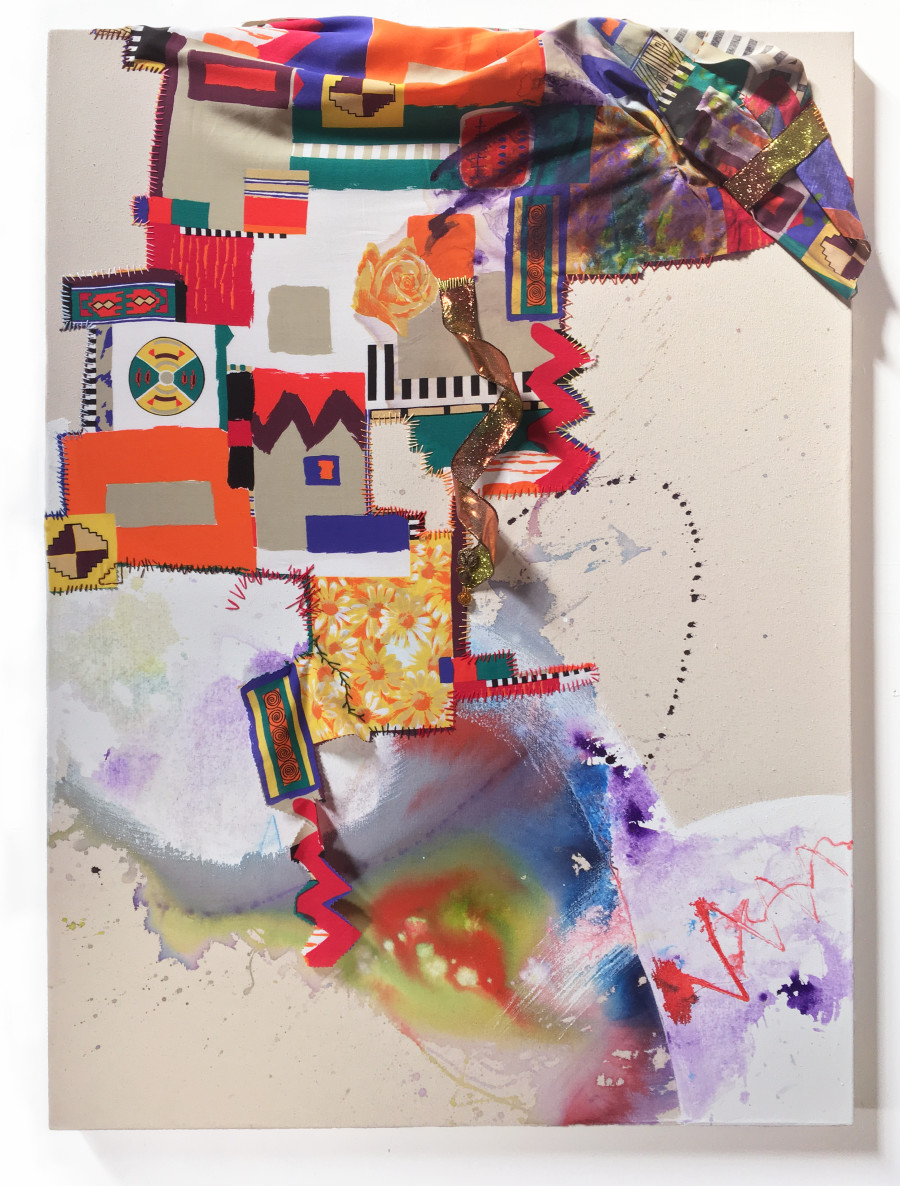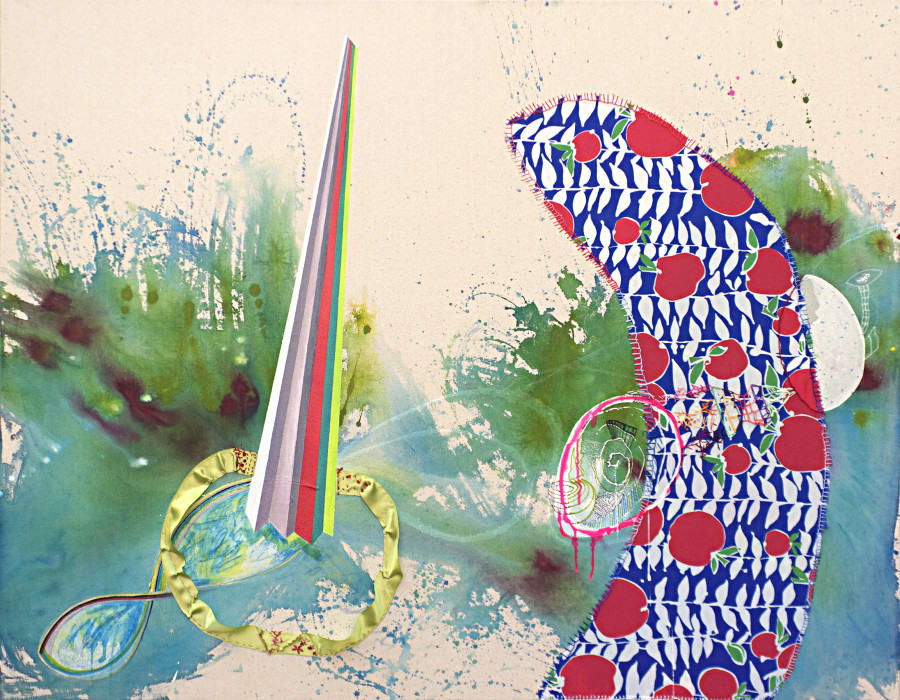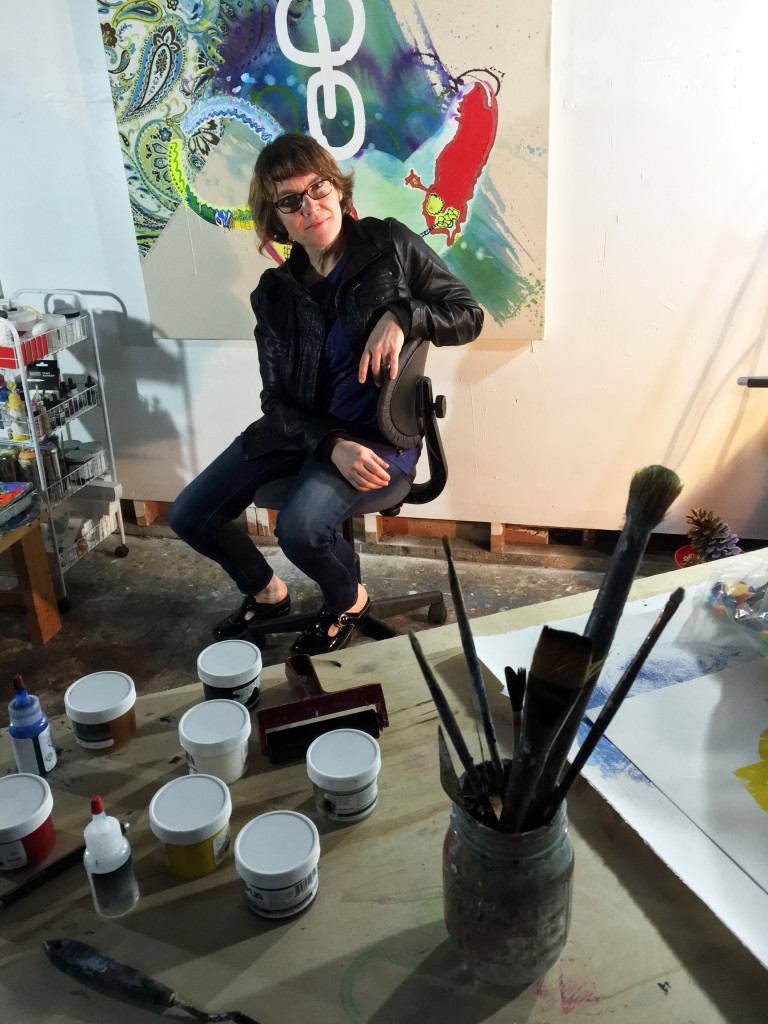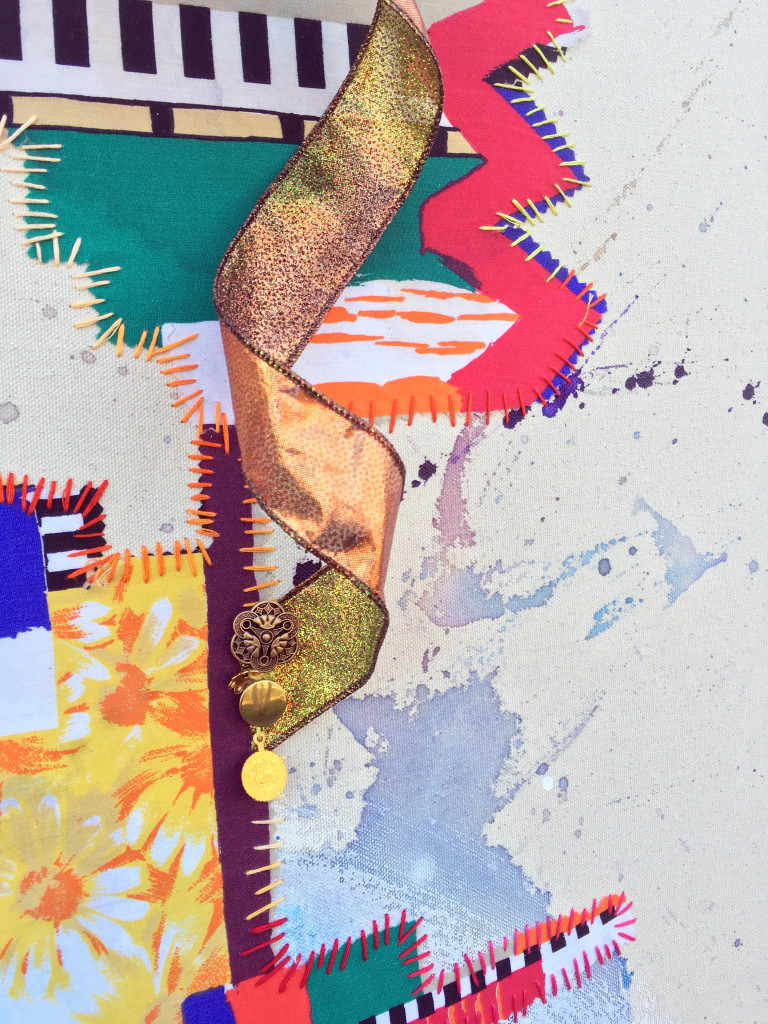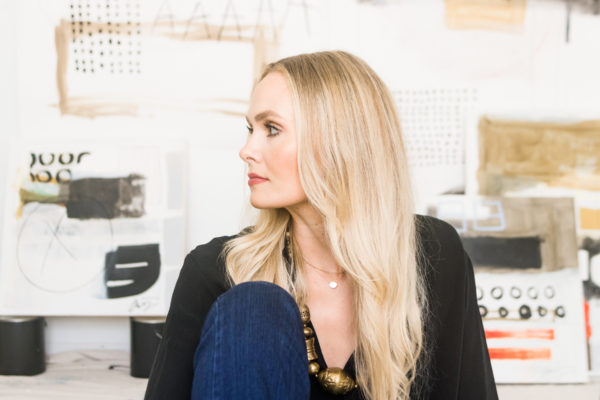Artist Vivian Liddell’s pieces are raw, bold and bursting with a creative signature style that’s all her own. The 44-year-old Memphis, Tennessee native uses paint, felted wool, embroidery, sandpaper and more to create an array of paintings, sculptures and multimedia work. After a stint at Georgia Tech studying architecture, Liddell switched gears and ended up graduating from the University of Georgia with a degree in photography. After a few back-and-forth moves from Athens to Brooklyn (where she got her MFA in painting at Pratt) and back again, she’s now put down roots in the South—and shown a handful of pieces at various art shows here in ATL.
We talked to Liddell about charting new artistic territory, creating art as a mom and why you shouldn’t always listen to your parents.
CommonCreativ: What first sparked your interest in art?
Vivan Liddell: My great-grandmother was a hobby painter in Alabama, and I can remember sitting on her dining room floor at a very young age watching her make still-life paintings of fruit. The smell of the oil paint and her skill to magically recreate reality on canvas—that definitely made a huge impression. But I’ve always been inclined to draw and observe. I recently found something I wrote in second grade stating my favorite things to do were to make art and play school. That’s pretty much what I still do today.
CC: Which medium did you start with?
VL: I started my training in architecture, then photography—my dad had me convinced that I had to pick a practical art form so I could make a living. My advice to all the young artists out there is: Don’t listen to your parents! It will save you a lot of time if you just start off doing what you really want to do, because eventually you will make your way to it anyway. For me, that very unpractical thing that I always wanted to do was painting. I started off working with mostly oils and did figure painting for around 10 years. A large part of that for me was proving to myself that I was good enough. I had always thought that the mark of a true painter was whether or not you could produce a beautiful likeness. I think that’s how my family saw it. I went to Pratt to study the technical stuff (now I realize that was an odd choice—Pratt’s not exactly known for their figure painters) and also because I wanted to be in New York and Pratt was the only art school in NYC with a campus.
CC: How did you transition to other mediums like your mixed media work?
VL: When I was in Brooklyn, I was painting figures. Now that I’m back in the South, I’m into abstraction. I can be a contrarian, and that does kind of explain my artistic trajectory. I grew up around a lot of sewing and crafts, but I never wanted to do those things. Partially because that’s a creative outlet that women are supposed to have. But, to be fair, the real problem for me was probably more the lack of creativity than the medium. My mom and grandmother were not making their own designs; they were executing patterns. They would give me cross-stitch kits, which were basically busy work.
The big change in my work came when I had my second son and we decided to leave Brooklyn. I had been doing some craft projects (little dolls and stuffed things for kids) and silk-screening T-shirts at craft fairs to make extra money when I was on maternity leave from my teaching job. My studio there was a tiny area in the basement of our Crown Heights apartment with horrible lights; the other half of the basement was my son’s room. Every time I worked on a project, I would have to put it away when I left the room and there was only enough room to work on one thing—be it one painting, or one silkscreen, or one sewn stuffed animal—at a time. It was also at this point that I switched from oils to acrylic, since I was sharing a space with my oldest son.
CC: How has moving to the South affected your work?
VL: When I got to Athens, I had way more time. And space. My studio suddenly had a sewing station, a printmaking station, and room to work on multiple paintings. And I could just leave all these things out all the time. So eventually, the stuff I was making started to merge. It was partially the space; it was partially me stepping into motherhood. I did want a connection to my mother and my grandmother and with the sewing I’d done as a child. And I saw it differently once my sons started being interested in it—it became less gender specific. And to be totally honest, I had gotten sort of bored with representational painting because I had gotten good enough at it. It started to feel like the cross-stitch to me, where I was spending most of the time executing a plan, rather than creatively interacting with the work. Now when someone asks me what kind of work I do, I relish saying that I’m an abstract painter. No matter what medium I’m working in, it’s always about painting. I think that’s more obvious to me the more I use other materials. When I add sewn elements onto a painting, I’m more concerned with whether the canvas is taut than with how neat the stitching is. When I work in three dimensions, I want to play with anamorphic views to flatten things out.
CC: How would you describe your artistic style in a sentence?
VL: Formal painting with a bright palette that incorporates calligraphy, embroidery, and patterned fabric to create bold, abstract narratives.
CC: What inspires you?
VL: I’m really into the mundane and the little things. I feel the same as Georgia O’Keefe—that one job of the artist is to make you take a second look at things you would normally pass over. I do some of my best thinking on my commute and a lot of road imagery shows up in my work. It’s the intersection of the man-made and the natural. I love cars and trucks (and the way we adorn them) and the peripherals of the contemporary urban landscape, like cell towers. My children are a constant source of inspiration. Watching them and their joy in creating art has been absolutely a transformative experience for me and has made me want that again for myself. I teach art and so sometimes can get bogged down in the history, but the pure joy of mark-making is something that I’ve been relearning from my children. I also listen to a lot of music when I’m working, so sometimes you’ll see some narrative or marks that are specifically related to whatever I’m listening to.
CC: What have been some of your greatest achievements as an artist?
LV: That I grew up in one environment and kind of fearlessly jumped into something completely different (the New York art world)—I look back on my younger self and see the braveness in that. And I don’t want to put my children into the obstacle category, but I think that being a professional artist while being a parent is still a rare thing for women. You don’t graduate from art school and become an artist like you graduate from law school and become a lawyer. You work a day job while you build your art career on the side. And when you throw kids into that mix, many people end up tossing the art career out before they’ve had time to learn. I’m persistent, and I have a very supportive partner. I’m proud of myself, and grateful to him, for allowing me to continue to create art even when it’s been inconvenient, bankrupting, or at odds with reason.
CC: Who are some of your favorite artists?
VL: Jean-Michel Basquiat, Elizabeth Murray, Julian Schnabel, Mike Kelly, Sigmar Polke, Albert Oehlen. I’m really into the ‘80s! The more recent work of Frank Stella and Richard Tuttle—with a kind of combination of whimsy and complexity. Steve Di Benedetto’s paintings are mind-blowing—again, with the complexity of the systems. Joanne Greenbaum. And there are so many new contemporary artists out there that I find inspiring. Taitiana Berg’s work with the pyramids was eye-opening for me because of their simplicity and boldness.
CC: You’re based in Athens, but you’ve shown at spots in Atlanta—what do you think about the current state of Atlanta’s art scene?
VL: I went back and forth from Georgia to New York for a while, and I’ll admit I did that because I felt there was something missing in the Atlanta scene, particularly the painting scene—like a critical mass. But a lot has changed in the past 10 years. The local institutions are supporting local artists. The Atlanta economy and population are more diverse, with the movie and tech industries bringing money into the creative sector. And you have a lot of artists like me, who previously would have stayed in New York, coming back or staying in their home states to build their careers. The internet has kept me satiated on some level; I don’t feel like I necessarily need to be in New York to have an idea of what’s happening. Of course, painting needs to be seen in person (and I still travel quite a bit to see work), but the web gives you a way to connect with other like-minded locals and still keep tabs on the rest of the art world in real time. My main lens on the Atlanta scene comes from participating in the SEEK studio group. It’s a great community of artists, and so much interesting work is happening. They’re really open to anyone coming, and there’s a constant flux of artists and a level of professional feedback that’s hard to come by outside of academia. It’s been a crucial way for me to find and connect with other artists who are in this for the long haul. Shout out to Ben Steele and Brendan Carroll for running the studio visits and stewarding this crucial program.
CC: What are some of your favorite places in Atlanta?
VL: I have a nostalgic fondness for Midtown from my Georgia Tech days and am always looking for an excuse to go to Eats or Fellini’s on Ponce. I’m usually in town to do something art related, and I like to pick a spot where there a few galleries within walking distance, so I end up on the Westside a lot. There’s so much going on, I like to try at least one new thing whenever I’m in the city. If I have my kids with me, we like to go to the Fourth Ward park and the BeltLine.
CC: What’s next for you in 2016?
VL: Lots of exciting stuff. I recently had two pieces in the Contemporary South show at the Visual Art Exchange Gallery in Raleigh, North Carolina. I had a large-scale painting installation up in Gainesville at the Quinlan as part of the UNG Faculty Exhibition (with a large soft sculpture and several smaller wood-carved figures inspired by Hopi Kachina dolls), and I have two upcoming solo exhibitions. The first one will be at Piedmont College in Demorest for the month of March. And I’m super psyched for a solo show at Eyedrum in the fall. I’m trying to rein in some big ideas right now, but I’m planning on pairing some soft sculptures with paintings. The Eyedrum show is a huge deal for me, in terms of just having that much space to work with and because I’m branching into 3-D territory and actually calling some works “sculpture.” For the past few years, even when I’ve made 3-D things, they were still primarily paintings. These new things are going to relate to the paintings, and have painted elements, but they will definitely be sculptures. There’s a lot of buzz in the world of women right now with the dialogue of self-depreciation and unnecessary apology coming to a close. These sculptures are my way of participating in that. I’ve always said “Oh, I can’t do 3-D…” , but you know, maybe I can.
CC: Why do you make art?
VL: I love to do it. It’s all encompassing and allows you to follow whatever path you need to follow in the most open way. You can be political, meditative, angry, happy, social and/or anti-social—all in the same piece. So it keeps my attention in a way that nothing else does. But it’s not really a choice for me. I need to do it for my mental health. We’ve had a lot of rain lately in big batches, and at the end of it I’ve had conversations with people about how everyone’s kind of depressed. That’s how I feel if I don’t make art—like the sun isn’t out.
Find more of Vivian’s work on her website, Instagram and Twitter.

